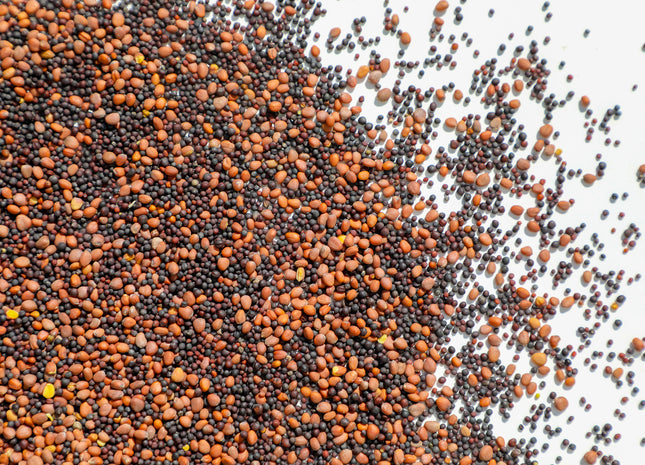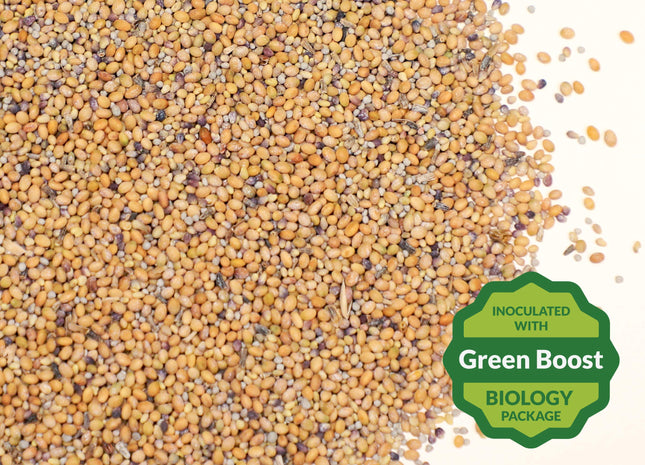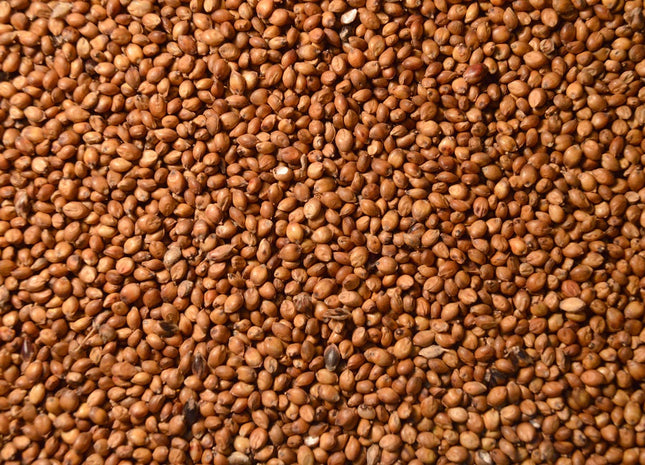Products


African Cabbage
African cabbage, a robust and rapidly growing brassica, thrives in a variety of warm season mixes, which makes it an intriguing option for interseeding into corn mixes. What sets it apart is its unique ability to stand tall and keep its leaves even in the face of cold weather, making it an exceptional choice for a snow-catching cover crop. Its enduring residue and strong root system enable captured snow to seep into the soil, enriching the moisture content in your land.
from $2.38 per lb


Arugula (Roquette)
What is usually known as a salad green, arugula can also be used in cover crop mixes. Arugula is a dense, low growing brassica other than its white flower when it bolts. The bitter taste and smell of arugula is an indication that the glucosinolates give it a natural biofumigant use similar to mustards. Arugula is a very long season plant and if spring planted will stay green late into the fall.
from $2.25 per lb

Brassi-Cast
Brassi-Cast is a full brassica mix designed to be broadcast into standing crops prior to harvest. This mix works well broadcast into seed corn acres or other cash crop scenarios. The radish, turnip, rapeseed, and collards are all small seeded brassicas that will provide biomass and ground cover that is easily broadcast into a standing corn crop. Brassi-Cast is a great addition if you are planning to graze crop residue later in the year. You can also plan to drill a cereal into the mix once the previous crop is harvested. Use this mix to... protect soil from erosion add diversity improve nutrient cycling Ideal for... row crop farmers corn producers These seeds are non-GMO and not treated with pesticides. This product is pre-inoculated with Elevate'd Fungi and AEA's SeedFlare to increase the biological activity in your soil. Elevate'd Fungi is OMRI approved. SeedFlare is NOT OMRI approved.
from $1.75 per lb


Brown Mustard (Kodiak)
Mustard produces significantly more glucosinolates than other brassicas, which biofumigates the soil during decomposition, proving to be toxic to many soil pathogens and pests. To best utilize these glucosinolates, mature green vegetation should be turned into the soil. In no-till operations you will still benefit from having this species for this use. When allowed enough growing season, brown mustard stem residue can remain erect throughout the winter months and aid in capturing snow to help build moisture in the soil profile. Growing mustard in a potato rotation was observed to increase tuber quality and yields similar to that of chemically fumigated fields. Other documented effects of having mustard in your rotation is suppressing potato early dying and reduced root rot in pea rotations. Some customers are concerned that these mustards are difficult to control like their wild cousins but actually they can be easily terminated with many commonly utilized herbicides.
from $2.50 per lb


Faba Bean
Faba beans are one of the oldest plants under cultivation, having been grown in ancient Greece and Rome. Unlike other beans, they can tolerate cool, wet soils. While they may not overwinter in much of the US, they can survive a light frost which is advantageous if planted in a fall or spring mix. As a legume, these beans will fix nitrogen in the soil for other plants to use. Their tremendous root system will help break compaction and hold soil in place. Faba beans do not like heat and when the plants die they turn black.
from $0.85 per lb


Forage Soybeans (Laredo)
Laredo Soybeans are an older soybean variety that is distinguishable from most other soybean varieties since the seed is black in color. This non-GMO forage soybean is an excellent addition to grazing and haying mixes. If you already use soybeans in your rotation, however, we recommend staying away from the forage soybeans as they can carry disease that could affect your soybean crop.
from $1.60 per lb

Frost Seed Release
Is there some bare ground or a food plot that isn’t very productive where you hunt that should be converted to producing high-quality forage during the first of spring green up? If so, then the Frost Seed Release blend is for you. This blend consists of cold-hardy clover seed that doesn’t require much moisture to germinate. The result? A great clover plot for the spring. This blend features cold-hardy clover varieties that we selected for their ability to germinate in the low moisture conditions and cooler soil temperatures of early spring, ensuring your plot greens up sooner rather than later and allows for capitalizing on frost seeding opportunities for maximum coverage and growth. This allows for the efficient use of resources by requiring less moisture for germination, Frost Seed Release makes the most out of the limited conditions of early spring, providing a cost-effective and minimal effort option to producing high quality forage during the spring and summer. The quick germination of these clover varieties means your plot can attract and feed deer and turkeys. This blend not only feeds wildlife but also improves soil health, setting the stage for future plantings with its nitrogen-fixing properties. Choose Frost Seed Release for a food plot that's ready to welcome spring with open arms, ensuring your land is a vibrant, productive habitat from the very first signs of green. This product is pre-inoculated with the Green Boost 2.0 Biology Package, so you can reduce your fertilizer usage. Green Boost 2.0 includes: MycoGreen NPK is a dual inoculant containing ten functionally diverse mycorrhizal fungi and eight bacterial species. Elevate'd Fungi is a seed applied inoculant derived from natural products designed to stimulate seed germination, increase root and biological biomass in the soil, and improve soil structure. RhizoBac X-Tend features high concentrations of multi-species nitrogen fixing rhizobia for peas, vetch, cowpeas, sunn hemp and soybeans. Additionally, free living nitrogen fixing and phosphorus solubilizing bacteria combine for a robust broad spectrum seed treatment for your cover crops. Healthier and more vigorous plants will lead to healthier animals and bigger antlers! Green Cover was not able to source all these seeds from organic certified production. All seeds are non-GMO and non-treated.
from $62.00


Grain Sorghum (Food Plot)
Grain sorghum provides an excellent opportunity for feeding wildlife. The grain heads, which mature in late summer to early fall will attract the wildlife species and provide superior nutrition. Grain sorghum is an excellent option for upland birds in particular.
from $3.05 per lb
- Out of Stock


Milpa Garden Warm Season
The Milpa technique originated in Central America where the Maya used the three sisters: corn, squash, and beans alongside other native and cultivated plants to improve the soil and grow food in their forest gardens. Inspired by this concept, we’ve created a mix of over 40 different seeds including multiple varieties of Squash, Cucumbers, Watermelons, Turnips, Sunflowers, Okra, and many more. By planting this diverse mix altogether, we can grow healthful food that builds healthy soil. Harvesting the Milpa garden is an adventure in experiencing the power of natural diversity firsthand. Not only does Milpa produce delicious food, it attracts beneficial insects, reduces pressure from pests, and increases organic matter in the soil. Enjoy watching life explode right before your eyes and bring home tons of homegrown food throughout the season. Use this mix to... produce a wide variety of edible plants add diversity build soil organic matter Ideal for... home gardeners/homesteaders farmers
from $2.51 per lb


Mung Beans
Mung beans are a warm-season legume known for their remarkable heat tolerance and drought resistance. They exhibit rapid growth, maturing in just 65 days. One advantage of mung beans over cowpeas is that their seed pods remain intact, unlike cowpeas, making them an excellent source of late-fall protein for grazing livestock or wildlife. However, it's important to note that mung beans are highly susceptible to cold weather and require a minimum of 60 frost-free days to ensure successful growth. They can be used for both hay production and grazing and are compatible with peanut inoculant. Mung beans typically reach a height of around 3 feet and have a low to medium water usage. Their strengths lie in nitrogen fixation, forage production, and hay production.
from $1.45 per lb
- Out of Stock

Non-GMO Soybeans (KS5120NS)
These non-GMO soybeans are an excellent addition to a summer grazing crop, a post-small grain nitrogen fixing crop, or as a food plot for wildlife. It's a group 5 bean with indeterminate growth habit so the forage production potential is very high. This is a great, high protein forage for livestock.
from $1.00 per lb


Organic Jerry Spring Oats
Note: This product is certified organic. Spring oats are an excellent choice for quick ground cover in the spring or fall. Rapid growth aids in stabilizing disturbed or bare soil from environmental conditions. Spring oats make a great addition to any spring grazing or forage mix providing ample tonnage for your livestock. Fall plantings commonly winterkill. Residue from oats suppress winter annuals and protect the soil throughout the winter and will decompose rapidly in the spring. Allelopathic chemicals released by the decomposing residue suppress weed germination for a few weeks. The high quality oat forage is more palatable than rye or wheat. Also, oat is less prone to insect problems than either wheat or barley.
from $0.45 per lb
- Out of Stock


Organic Radish
Note: This product is certified organic. Rapid fall growth in short windows, allows radishes to fit perfectly into a traditional corn and soybean rotation. Radish residue breaks down very quickly in the spring, leaving a clean seed bed until early April. The residue has been proven to inhibit small seeded annuals from germinating. Nutrients that were scavenged are readily released back into the soil for the subsequent crop. A field planted in radishes, will allow the soil to dry and warm faster in the spring. The large root channel left behind is rich in nutrients, allows tremendous water infiltration, reduces water erosion, and a path for crops roots to follow through compacted soil layers. During decomposition, radish biofumigates the soil which can reduce pest and nematode populations.
from $3.07 per lb
- Out of Stock


Organic Radish: Tap Master
Note: This product is certified organic. Rapid fall growth in short windows, allows radishes to fit perfectly into a traditional corn and soybean rotation. Radish residue breaks down very quickly in the spring, leaving a clean seed bed until early April. The residue has been proven to inhibit small seeded annuals from germinating. Nutrients that were scavenged are readily released back into the soil for the subsequent crop. A field planted in radishes, will allow the soil to dry and warm faster in the spring. The large root channel left behind is rich in nutrients, allows tremendous water infiltration, reduces water erosion, and a path for crops roots to follow through compacted soil layers. During decomposition, radish biofumigates the soil which can reduce pest and nematode populations.
from $2.80 per lb
- Out of Stock


Organic Rushmore Spring Oats (Certified)
Note: This product is certified organic. Spring oats are an excellent choice for quick ground cover in the spring or fall. Rapid growth aids in stabilizing disturbed or bare soil from environmental conditions. Spring oats make a great addition to any spring grazing or forage mix providing ample tonnage for your livestock. Oats can be easily chemically terminated and fall plantings commonly winterkill. Residue from oats suppress winter annuals and protect the soil throughout the winter and will decompose rapidly in the spring. Allelopathic chemicals released by the decomposing residue suppress weed germination for a few weeks. The high quality oat forage is more palatable than rye or wheat. Also, oat is less prone to insect problems than either wheat or barley.
from $0.50 per lb


Phacelia
Phacelia enhances just about any type of cover crop mix you could think of. From pollinator mixes, to soil building, to grazing, phacelia shines in many situations. This mighty broadleaf enhances soil nitrogen uptake, boosts soil organic matter, and can be used in low fertility environments. While forage yield is modest, it is palatable to livestock even at maturity. As a cool season plant, phacelia is best planted in early spring or late summer, similar to alfalfa. This plant is also known to scavenge potassium.
from $4.35 per lb


Radish (Nitro)
Rapid fall growth in short windows allows radishes to fit perfectly into a traditional corn and soybean rotation. Radish residue breaks down very quickly in the spring leaving a clean seed bed. The residue has been proven to inhibit small seeded annuals from germinating. Nutrients that were scavenged are readily released back into the soil for the subsequent crop. A field planted in radishes, will allow the soil to dry and warm faster in the spring. The large root channel left behind is rich in nutrients. It allows tremendous water infiltration and reduces water erosion by creating a path for crops roots to follow through compacted soil layers. During decomposition radish biofumigates the soil which can reduce pest and nematode populations.
from $1.55 per lb


Showy Flower Mix
Many cover crop species will have colorful blooms which add good aesthetic value and pollinator habitat, however, some situations call for a little extra flare. The Showy Flower mix combines true, showy flowers that you would traditionally find in the flower seed aisle as well as popular cover crop species. Planted at the beginning of summer, the Showy Flower Mix will provide beautiful blooms all the way into fall. With zinnias, poppies, cosmos and more, this will be a bouquet maker. Use this mix to... grow beautiful flowers attract pollinators add diversity Ideal for... gardeners and homesteaders flower enthusiasts
from $25.00 per lb

Spring Oats (Everleaf Falcon) - Certified
Everleaf Falcon spring oats are an improved variety of oats. Delayed heading and improved leaf density make this an excellent option for forage. These oats resist lodging, produce excellent tonnage, and provide high quality forage. The seeds are much darker than most oat varieties, maturing as a medium to dark brown seed. Everleaf Falcon oats should be used for grazing or any type of harvested forage.
from $0.35 per lb


Spring Oats (Rushmore)
Spring oats are an excellent choice for quick ground cover in the spring or fall. Rapid growth aids in stabilizing disturbed or bare soil from environmental conditions. Spring oats make a great addition to any spring grazing or forage mix providing ample tonnage for your livestock. Oats can be easily chemically terminated and fall plantings commonly winterkill. Residue from oats suppress winter annuals and protect the soil throughout the winter and will decompose rapidly in the spring. Allelopathic chemicals released by the decomposing residue suppress weed germination for a few weeks. The high quality oat forage is more palatable than rye or wheat. Also, oat is less prone to insect problems than either wheat or barley.
from $0.32 per lb


Sweet Clover (Hubam White) - OMRI Inoculated
Hubam White Sweet Clover can produce up to 9,000 lbs dry matter per acre over a summer after being oversown into a grain crop or direct seeded with a spring grain nurse crop. While its taproot is shorter and more slender than that of its biennial cousins, it still loosens subsoil compaction. Annual sweetclovers work best in the Deep South, from Texas to Georgia as they are not frost tolerant. There, they establish more quickly than the biennial types and produce more biomass in the seeding year in southern regions.
from $3.61 per lb


Sweet Clover (Yellow Blossom) - OMRI Inoculated
Yellow blossom sweet clover is not a true clover but is probably more closely related to alfalfa. Sweet clover leaves look much like alfalfa, but the margins of sweet clover leaflets are serrated around their entire edge whereas alfalfa is only serrated on the tip. It is typically a biennial, grows 2-6 feet high, and as the name implies, produces yellow flowers. When compared to the white flowering types of sweet clover yellow blossom blooms roughly 2 weeks earlier. It also matures earlier, usually grows less upright, possesses finer stems, and is less productive and less winter-hardy. However, yellow blossom sweet clover persists better in pastures and tolerate adverse conditions better than white varieties. In temperate climates with mild summers it can survive and thrive through a second year of production. Yellow blossom sweet clover adds lots of nitrogen and organic matter to a system.
from $3.75 per lb


Winter Camelina
Winter Camelina is the most cold tolerant brassica with the ability to overwinter in most areas. This brassica grows a small rosette in the fall and then grows upright after winter dormancy. This is a good brassica to add to later planted fall mixes in cases after fall harvested cash crops. Camelina can be a great addition ahead of spring cash crops with its ability to scavenge nitrogen and phosphorus.
from $2.38 per lb

































